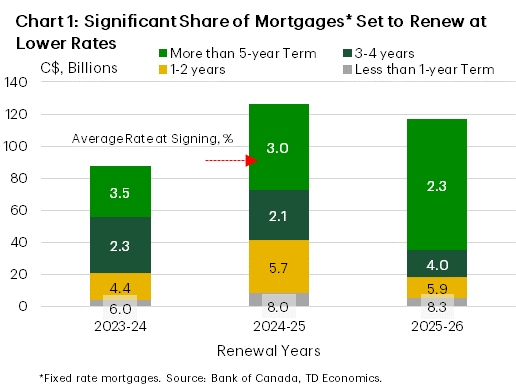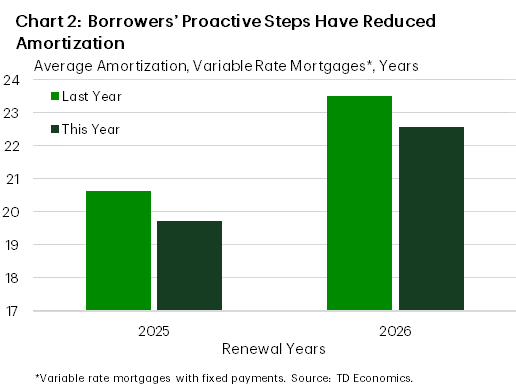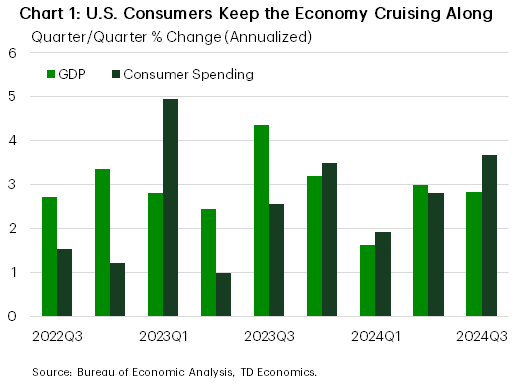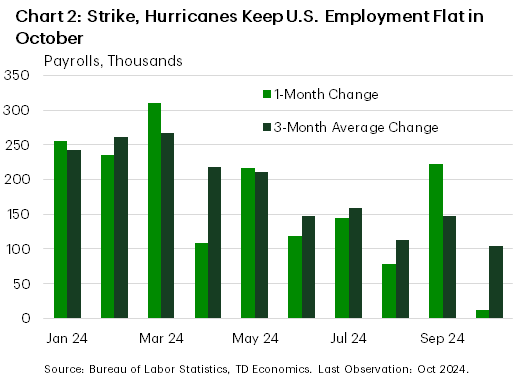Canadian Highlights
- A call for a jumbo cut to head off mortgage reset rates must be assessed carefully. Surprisingly, roughly a quarter of mortgages will reset at a LOWER interest rate next year.
- For those renewing into higher rates, the shock might be milder than expected, given a 30% increase in home prices and wages. Years of debt repayments have also built equity room, which homeowners, including those with variable-rate-fixed-payments mortgages, can use to lower payments if needed.
- While rapid rate cuts can relieve mortgage pressures, they also stoke risks. Restoking housing demand, pulling forward consumer spending, weakening purchasing power and dampening investment through a softer loonie. Indeed, there is such a thing as too much of a good thing.
U.S. Highlights
- The U.S. economy expanded by a robust 2.8% quarter-on-quarter (annualized) in the third quarter, only a touch slower than the 3% pace seen in Q2.
- Growth in both income and consumer spending picked up in September while core PCE inflation held steady at 2.7% y/y.
- Employment was essentially flat in October, with the economy adding a meager 12k jobs – well below the already-low 100k consensus estimate. The ongoing Boeing strike and disruptions related to Hurricanes Helene and Milton both weighed on the headline.
Canada – Canada’s interest rate conundrum: Too much of a good thing
Last week, we published on the Bank of Canada’s decision to deliver an outsized 50-basis-point interest rate cut. Some clients have commented that a faster descent is necessary to head off mortgage renewal risks. The concern is embedded in the lingering effects of the pandemic. In 2020, home sales shot up 40% in just twelve months as the Bank of Canada slashed the policy rate to near-zero. Homebuyers responded to a once-in-a-generation deal on mortgage rates. Now as 2025 approaches, those renewing a 5-year mortgage – the preferred term in Canada – could face sticker shock.
Chart 1 offers some comfort with three key messages:
First, it will likely surprise many that roughly a quarter of mortgages will reset at a LOWER interest rate. Many homeowners in the past two years selected shorter mortgage terms in the hopes that the Bank of Canada would be cutting rates as renewals hit. Good call! The savings will be tremendous. Depending on the institution, the current 5-year mortgage rate is between 4.0% and 4.7% compared to the prior average transaction rates of 5.8% to 6.9% for those folks. That’s a huge step down that will free up disposable income.
Second, the majority of mortgages coming up for renewal next year and in 2026 sit at an average rate of 2.5%. There will be upward pressure on monthly payments for these folks. However, not as much as you might think. Since 2020, Canadian home prices and wages have both risen by over 30%. And five years of debt paydown has created equity room that could be taken back up if homeowners want to mitigate the increase in monthly mortgage payments by extending their amortization.
The benefits of lower rates and higher equity hold true for variable rate mortgage holders too. Those with variable payments have already experienced some rate relief due to 125 basis points in interest rate cuts so far. For a $500,000 mortgage, this translates to a $370 reduction in the monthly payment. For borrowers whose payments do not adjust with rate changes, these reductions will bring benefits at renewal in the form of either lower monthly payments or a shorter amortization period. Moreover, it appears that this group is faring better than initially anticipated when analysts looked at the data a year ago. Many borrowers have proactively increased their payments, effectively reducing their average amortization period by a full year (Chart 2).
Lastly, financial risks are further lowered than many Canadians presume due to past macroprudential rules. Canada’s mortgage stress test requires mortgage applicants to qualify not at their contract rate, but at an interest rate that is two percentage points higher, or a floor rate of 5.25%, whichever is higher. With the 5-year mortgage rate floating at around the 4% mark, homeowners who secured rates in the 2% range in 2020 remain within the scope of that stress test. If they qualified then for a mortgage, they should be sitting in a better spot today with the benefit of time and wage gains, presuming there hasn’t been a change in the household income status. Given the lack of job losses in the job market, this assumption holds true for most.
Bottom line, when rates were rising rapidly, mortgage renewals were on everyone’s mind as a key risk that required flagging by the Bank of Canada. But it no longer presents itself as that lurking monster of 2025. By extension, it’s not the smoking gun for ongoing 50 basis point rate cuts. It’s important to balance the two-sided nature of risks. The other side is inadvertently restoking the housing market, leading to a new cycle of restrained affordability and debt accumulation. The Bank must also be mindful of underestimating the spending impulse. A more rapid rate-cut cycle will pull forward or front load consumer spending relative to a gradual cycle. Because data is lagged, by the time it’s readily observed, the momentum impulse could be stronger than anticipated and require course correction. And finally, caution is warranted in creating too wide an interest rate spread to the U.S.. The loonie has already broken below a technical threshold by dipping below 72 cents. Chronic weakness reduces Canada’s purchasing power abroad, which can become counterproductive to investment because firms source a significant amount of machinery and equipment from other countries.
We must remember, there is such a thing as too much of a good thing.
U.S. – The U.S. GDP data delivers treats, but the payrolls report plays tricks
Next week all eyes will be on the U.S. elections and the Federal Reserve meeting. However, this week the focus has been on the health of the U.S. economy – an important reference point for both presidential candidates and the Fed.
Wednesday’s advanced GDP report showed that the U.S. economy is alive and well. Coming on the heels of the solid 3% gain in Q2, the economy expanded by 2.8% (quarter-over-quarter annualized) in Q3. Consumers were the belle of the ball, with spending accelerating to 3.7%, or the fastest pace since Q1 2023 (Chart 1).
This ongoing resilience was further echoed in September’s personal income and spending report. It showed that spending increased by 0.5% m/m in September, outpacing income and indicating that consumers kept their purse strings open as Q3 wrapped up. Lower prices at the pump in recent weeks may have boosted confidence, giving consumers some reprieve from the ever-rising prices elsewhere. On that front, core PCE deflator – which excludes food and energy – rose 0.3% m/m in September. This held the twelve-month change steady at 2.7% for the third consecutive month, but this was largely due to “base effects”. Importantly, the 3-and-6-month annualized rates of change sit just above the Fed’s 2% inflation target, suggesting we’re likely to see more downward pressure on the year-ago measure in the months ahead.
As we noted in a recent report, there are several reasons consumers may have more momentum than previously anticipated, such as a notable upgrade to personal income in first half of 2024 and a larger buffer of savings. However, the savings cushion is quickly dwindling, with the personal saving rate having now declined for three consecutive months. This suggests we’re likely to see some moderation in consumer spending to something more consistent with a trend-like pace of around 2% in the months ahead.
On that note, October’s payroll report was expected to be a weak one, but still surprised to the downside. The economy added just 12k jobs in October, well below the expectation for a 100k gain, while. Adding to the disappointment, downward revisions shaved 112k from the two prior months’ gains. The ongoing Boeing strike helped to cut over 40k from the headline number in October, while Hurricanes Helene and Milton also likely had a heavy hand weighing down the payrolls figure.
As a result, the Fed will likely look through October’s noisy employment data, and instead focus more on the broader trends showing that the labor market is decelerating but not necessarily deteriorating. Moreover, with the Fed’s preferred wage metric – the Employment Cost Index – showing wage pressures now growing at a pace roughly consistent with 2% inflation, the FOMC should have all the confidence they need to continue to gradually reduce the policy rate. We expect the Fed to cut by 25 basis-points at next week’s meeting. While this decision seems almost certain, the U.S. elections remain a wild card, promising to keep everyone on edge until the final votes are tallied.


















